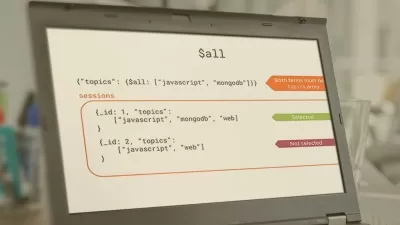MongoDB 101: Beginner's Guide to MongoDB
SKILL CURB
4:04:37
Description
Understanding MongoDB's Document-Oriented Data Model. Learn, understand and practice fundamentals of the MongoDB.
What You'll Learn?
- What document databases are and how data is organized with MongoDB
- Performing fundamental Create, Read, Update, and Delete operations in MongoDB to interact with your data.
- Writing complex and efficient queries to retrieve the information you need from your MongoDB database.
- Use all features MongoDB offers you to work with data efficiently.
Who is this for?
What You Need to Know?
More details
DescriptionAre you ready to unlock the power of MongoDB, one of the most popular NoSQL databases used by developers and organizations worldwide? "MongoDB 101: Beginner's Guide to MongoDB" is your gateway to understanding the fundamental concepts of MongoDB and acquiring the skills to work with this flexible, scalable, and high-performance database system.
Get ready for the “MongoDB 101: Beginner’s Guide to MongoDB†complete course. Gain familiarity with the course details and topics designed to help you succeed.
MongoDB offers a flexible and efficient way to store, manage, and retrieve data, making it a vital tool for web and application developers, database administrators, and data enthusiasts.
No matter if you're building web applications, mobile applications, or any other kind of application or if you're a data scientist - you'll need to work with data. Storing data, querying it efficiently, and minimizing complexities whilst optimizing performance are crucial tasks.
In this comprehensive course, you will embark on a journey that takes you from MongoDB novice to proficient user. We will start with the basics and gradually delve into more advanced topics, ensuring you gain a thorough understanding of this robust database system.
Learn about MongoDB with Hands-On Labs
The MongoDB 101: Beginner’s Guide to MongoDB is a hands-on practice course designed to familiarize you with the core functionality of ChatGPT and its plugin system. Through hands-on exercises, throughout this course, you'll master the fundamentals of MongoDB, starting with the core concepts and gradually building your expertise. Whether you're a developer aiming to enhance your skills or a newcomer to the world of databases, you'll find this course both accessible and rewarding.
The course comprises approximately 50 labs starting from the basics and moving to high levels in terms of complexity.
Who should take this course?
The course "MongoDB 101: A Beginner's Guide to MongoDB" is designed for a wide range of individuals who are interested in learning about MongoDB and NoSQL database management. It is particularly suitable for Both aspiring and experienced developers who want to add MongoDB to their skill set. Whether you're a web developer, mobile app developer, or software engineer, understanding MongoDB is valuable for building data-driven applications. This course is also useful for Database administrators who want to expand their knowledge beyond traditional relational databases and gain expertise in NoSQL databases like MongoDB. Anyone with an interest in data management, data science, or data analytics who wants to explore MongoDB as a powerful tool for working with unstructured and semi-structured data can benefit from this course.
Course Content
In Section 1, we will learn to Install and set up MongoDB: We'll guide you through the installation process and show you how to configure MongoDB for your specific needs.
In Section 2, we explore some fundamental concepts of MongoDB. We’ll discover how to create databases, collections, and documents in MongoDB, and master the art of querying data efficiently.
In Section 3, explore performing "CRUD Operations" in MongoDB. We’ll explore different scenarios of creating, updating, reading, and deleting documents in MongoDB using Mongo shell.
In Section 4, we’ll explore some query and projection operators that we can use to make our querying more efficient and get specific documents as a result.
Section 5 introduces you to the update operators that you can use to update your documents or specific fields of the document on the basis of certain criteria.
In Section 6, we’ll explore data modeling in MongoDB and some approaches for how you can implement relationships between collections
Section 7 delves into "The MongoDB Compass" by providing you with the required knowledge to start using MongoDB Compass if you are more comfortable with using GUI than using CLI or shell.
Finally, in Section 8, we’ll integrate MongoDB with programming languages and frameworks. We’ll see how you can use MongoDB with Python and then we’ll see how you can use MongoDB with Spark using Databricks.
Who this course is for:
- Students pursuing degrees in computer science, software engineering, data science, or related fields can gain valuable insights into MongoDB as part of their education.
- IT professionals, system administrators, and network administrators who want to understand MongoDB's role in modern technology and infrastructure.
- Database administrators who want to expand their knowledge beyond traditional relational databases and gain expertise in NoSQL databases like MongoDB.
- Anyone looking to increase their productivity with databases.
Are you ready to unlock the power of MongoDB, one of the most popular NoSQL databases used by developers and organizations worldwide? "MongoDB 101: Beginner's Guide to MongoDB" is your gateway to understanding the fundamental concepts of MongoDB and acquiring the skills to work with this flexible, scalable, and high-performance database system.
Get ready for the “MongoDB 101: Beginner’s Guide to MongoDB†complete course. Gain familiarity with the course details and topics designed to help you succeed.
MongoDB offers a flexible and efficient way to store, manage, and retrieve data, making it a vital tool for web and application developers, database administrators, and data enthusiasts.
No matter if you're building web applications, mobile applications, or any other kind of application or if you're a data scientist - you'll need to work with data. Storing data, querying it efficiently, and minimizing complexities whilst optimizing performance are crucial tasks.
In this comprehensive course, you will embark on a journey that takes you from MongoDB novice to proficient user. We will start with the basics and gradually delve into more advanced topics, ensuring you gain a thorough understanding of this robust database system.
Learn about MongoDB with Hands-On Labs
The MongoDB 101: Beginner’s Guide to MongoDB is a hands-on practice course designed to familiarize you with the core functionality of ChatGPT and its plugin system. Through hands-on exercises, throughout this course, you'll master the fundamentals of MongoDB, starting with the core concepts and gradually building your expertise. Whether you're a developer aiming to enhance your skills or a newcomer to the world of databases, you'll find this course both accessible and rewarding.
The course comprises approximately 50 labs starting from the basics and moving to high levels in terms of complexity.
Who should take this course?
The course "MongoDB 101: A Beginner's Guide to MongoDB" is designed for a wide range of individuals who are interested in learning about MongoDB and NoSQL database management. It is particularly suitable for Both aspiring and experienced developers who want to add MongoDB to their skill set. Whether you're a web developer, mobile app developer, or software engineer, understanding MongoDB is valuable for building data-driven applications. This course is also useful for Database administrators who want to expand their knowledge beyond traditional relational databases and gain expertise in NoSQL databases like MongoDB. Anyone with an interest in data management, data science, or data analytics who wants to explore MongoDB as a powerful tool for working with unstructured and semi-structured data can benefit from this course.
Course Content
In Section 1, we will learn to Install and set up MongoDB: We'll guide you through the installation process and show you how to configure MongoDB for your specific needs.
In Section 2, we explore some fundamental concepts of MongoDB. We’ll discover how to create databases, collections, and documents in MongoDB, and master the art of querying data efficiently.
In Section 3, explore performing "CRUD Operations" in MongoDB. We’ll explore different scenarios of creating, updating, reading, and deleting documents in MongoDB using Mongo shell.
In Section 4, we’ll explore some query and projection operators that we can use to make our querying more efficient and get specific documents as a result.
Section 5 introduces you to the update operators that you can use to update your documents or specific fields of the document on the basis of certain criteria.
In Section 6, we’ll explore data modeling in MongoDB and some approaches for how you can implement relationships between collections
Section 7 delves into "The MongoDB Compass" by providing you with the required knowledge to start using MongoDB Compass if you are more comfortable with using GUI than using CLI or shell.
Finally, in Section 8, we’ll integrate MongoDB with programming languages and frameworks. We’ll see how you can use MongoDB with Python and then we’ll see how you can use MongoDB with Spark using Databricks.
Who this course is for:
- Students pursuing degrees in computer science, software engineering, data science, or related fields can gain valuable insights into MongoDB as part of their education.
- IT professionals, system administrators, and network administrators who want to understand MongoDB's role in modern technology and infrastructure.
- Database administrators who want to expand their knowledge beyond traditional relational databases and gain expertise in NoSQL databases like MongoDB.
- Anyone looking to increase their productivity with databases.
User Reviews
Rating
SKILL CURB
Instructor's Courses
Udemy
View courses Udemy- language english
- Training sessions 52
- duration 4:04:37
- Release Date 2023/12/16











